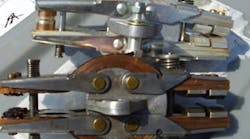The city of Conway (Corporation), Ark., lies 20 miles north of Little Rock. Conway’s city-owned electrical utility system includes two feeders out of its substation, one supplying an industrial customer, and the other supplying the balance of the small city’s business and residential customers.
“The industrial customer had detected what they considered a voltage problem,” says Emery Perry, a field application technician called in from Schweitzer Engineering Laboratories, Inc. (SEL, www.selindustrial.com) to consult on the situation. “Yet when technicians from the Conway Electric Department went to inspect the substation, they noticed that there was no trip on the breaker.”
Microprocessor-based relays can collect and save event reports during faults and other problematic conditions. For example, the event report and sequential events recorder (SER) capability of advanced relays that SEL offers enable engineers to gain a better understanding of faults and disturbances on transmission lines through event report analysis . This frequently leads to better line variables, more accurate locating for complex faults, and improved understanding of electric power system operations.
Event reports are useful for determining fault resistance and explaining otherwise inexplicable events. They also aid in testing and troubleshooting relay settings and schemes that protect costly equipment critical to consumer and industrial services.
Using the event reports can increase system reliability; reduce maintenance costs, and reduce the potential for system damage and resulting outages.
“The technicians at Conway Electric had received training on SEL equipment, enabling them to take full advantage of the event report records in the SEL relays,” Perry says. “The technicians decided to check the event history in the SEL relays to learn if there were any relevant event reports on the feeder in question.”
They found that existing event reports seemed to indicate a voltage problem. So they consulted Perry to confirm what was evidently an unusual problem. “From the oscillograph readings, it appeared that the problem could be in the source – and, in this case, the source was a transformer,” Perry says.
The Conway Electric Department uses SEL-351S-7 and SEL-351S-6 protection and breaker control relays and SEL-551 overcurrent/reclosing relays in its distribution substations. The SEL-351S-7 relay is used on the feeder main, with the SEL-551 as backup. The SEL-351S-6 relays provide feeder protection as well as reclosing.
Perry says the event records showed a decrease in C-phase current (IC) and C-phase voltage (VC), while A-phase and B-phase currents increased. “This occurred on two feeders. I suggested testing their transformer, which was a tap changer. When we inspected it, we found that the rotary tap changer contacts were severely worn.
Though it had not completely failed, the old bridge contact (bottom) was about ready to cause a fire, outage and unplanned shutdown.
“What was causing the problem was the C-phase on the utility transformer opening up, leaving the industrial customer in single phase,” he adds. “It wasn’t a complete opening; actually, the moving contacts in the transformer were arcing. That’s why the event report oscillograph showed the collapsed C-phase voltage and the collapsed C-phase current, just as if you were removing the voltage off of the load C-phase. There was a three-phase system within the facility that was actually single phasing, which could cause equipment damage. And of course, the arcing of the transformer damaged the contacts.”
Although transformers are generally among the most dependable components in an electrical system (failure rates are estimated at a minimal 76 failures per 10,000 years of transformer life), when failures occur, they can result in costly outages, considerable downtime and expensive replacements.
“In this case, I would say that early analyses of the event record helped prevent a possible transformer fire and a sustained power outage, and also possible damage to the industrial plant equipment from a continued single-phasing condition,” Perry says.
Each time an SEL relay generates a standard event report, it also generates a corresponding event summary. This is a concise description of an event that includes such information as relay and terminal identification; event type, date, and time; fault location; and more. Event summaries can be viewed using the front-panel LCD or front-panel serial port of the SEL-351S. The date and time of each transition are available in event reports, downloadable to any PC. The chronology helps technicians determine the order and cause of events to facilitate comprehensive troubleshooting. With an appropriate setting, the relay automatically sends an event summary in ASCII text to one or more serial ports each time an event report is triggered.
In addition to storing event summaries and full-length event reports, SEL relays can track the pickup and dropout of protection elements, control inputs, and contact outputs.
